Tis the season for gratitude! We have an awful lot to be grateful for, but just how grateful are we, especially at work? What kind of difference can gratitude make in the workplace? We spoke with a few of our experts to find out what gratitude looks like in the workplace and how leaders can develop and leverage it to benefit all stakeholders.
Answers From the Experts:
 Lyn Turknett, Co-founder and Co-chair, TLG
Lyn Turknett, Co-founder and Co-chair, TLG
What does gratitude look like in the workplace?
I just read that people are less likely to express gratitude in the workplace than anywhere else. Our “work mindset” is a problem – perhaps we put on our “professional” hats and leave our “thankful” hats at home
Gratitude is defined by researchers as a step beyond appreciation. They define appreciation as the act of acknowledging the goodness in life—in other words, seeing the positives in events, experiences, or other people (like our colleagues). Gratitude goes a step further: It recognizes how the positive things in our lives—like a success at work—are often due to forces outside of ourselves, particularly the efforts of other people. But this kind of thinking can seem countercultural in the realm of hierarchies and promotions, where everyone is trying to get ahead and may be reluctant to acknowledge their reliance on—or express emotions to—their co-workers.
One of the leaders I most admire is Frank Blake, former Chairman and CEO of The Home Depot. On Sunday afternoons he would write handwritten notes to several hundred associates across the enterprise, thanking each one for something specific they had done in a store. It occurred to me that the act of doing that might have changed him too, since it forced him to really reflect on how important those people were to his success.
Here are some of the things I think all of us – and especially all leaders – need to know about gratitude:
- Gratitude makes us happier and healthier. We know how important gratitude is. Research has demonstrated so many benefits, including indicating that grateful people are happier and live longer.
- We are less likely, though, to express gratitude at work. And 60% of people say they never even say thanks at work. That’s a problem – we spend so much of our life at work. but our behavior makes it a less happy place. We all want to be thanked and appreciated for what we do – how do we remember that at work?
- Leaders tend to express less gratitude – when their gratitude is likely most important to the culture overall. Narcissism – often present in leaders – and power are negatively correlated with feelings of gratitude and expression of gratitude.
- Humans tend to focus more in our life on what’s wrong than on what’s right. I know I personally do the same; for me, it’s a lifelong struggle not to complain, to envy others, and to focus on what others are doing wrong rather than what they are doing right. And that seems to be even more true in close teams. One of my favorite quotes has long been one from Robert Kegan and Lisa Lahey, and it goes like this: “We often see our lives as dramas in which we are cast ‘at the center as well-intentioned, beleaguered victim-heroes’.”
In this time when many of us are readying for Thanksgiving, how can we add more gratitude to our work lives? How can we remember that we are always dependent on others for our success? How can we focus more on the things that go right in our lives? And how can we maintain that awareness?
I’ve been trying to remember a quote I learned only in the past year:
“No amount of regret can change the past. No amount of worry can change the future. But any amount of gratitude can change the present.”
– Amy Voskamp
 Patricia Thompson, Ph.D., Senior Consultant, TLG
Patricia Thompson, Ph.D., Senior Consultant, TLG
What does gratitude look like in the workplace?
Gratitude in the workplace can look like appreciating what you have and showing thanks to others. On a personal level, with all the stresses and pressures that often coincide with work, it can be easy to lose sight of any of the positives. The simple act of taking a step back, and acknowledging what you appreciate can be grounding, and help to provide a more balanced view of your experience. Some specific practices you could employ could include being more intentional about savoring your successes, taking time at the end of the day to write down what went well, or recognizing the aspects about your work that you enjoy.
How can leaders develop and leverage the benefits of gratitude for employees in the organization as a whole?
To demonstrate gratitude to others, look for opportunities to say thank you. For example, you could write a formal note for a job well done. Or, you could make sure to catch people doing something right (instead of just looking for areas in need of improvement). Or, you could say a genuine “thanks” with a sense of presence. And, if you’re a leader, encourage others to do the same. Cultures of gratitude are linked to people experiencing more positive emotion, less stress, higher job satisfaction, and even fewer sick days.
 Susan Hitchcock, Founder of Women in Leadership and The Age of SHEroes, TLG
Susan Hitchcock, Founder of Women in Leadership and The Age of SHEroes, TLG
What does gratitude look like in the workplace?
To me, gratitude in the workplace is experienced when everyone feels that they’re valued and respected. It’s a two-way street where each employee at whatever level comes to their job with the full intention of doing their best and helping their organization be the best. As a manager, supervisor, boss or owner, you are grateful when you know that you’ve created a culture where everyone has the opportunity to contribute and be recognized for it. When you can say, “I’m glad to work here, and I’m proud of who we are as a company or organization,” then you genuinely are and should be grateful.
How can leaders develop and leverage the benefits of gratitude for employees in the organization as a whole?
Leaders can start by actively listening to their people; trying to understand what inspires and engages them; and ensuring that everyone has a sense of belonging and contributing. Employees want to be heard, valued, and recognized, and that isn’t just about compensation. Especially to the younger generations, it means knowing that their organization or company has purpose and that it’s not all about profit. Also, leaders who are open, who are approachable, who admit mistakes / show vulnerability, and who seek to understand different perspectives – they are the kind of leaders that employees are grateful to work for and with.
 Bill Dickinson, D. Min, RCC, Senior Consultant, TLG
Bill Dickinson, D. Min, RCC, Senior Consultant, TLG
What does gratitude look like in the workplace?
I remember when I said to a colleague once, “I know you’re pushed, give me one of the items you must get done in the next 48 hours”, and the look on her face not only conveyed relief but also gratitude.
So, what does gratitude look like? It looks like a commitment to another. It looks like recognition, expressed as they want to receive it, for the “extra effort”. It looks like the end of a team meeting—20 minutes early—because we didn’t stretch out the allotted time frame. It looks like a stretch assignment knowing that it will help to advance one’s career. It looks like joy for the birth of a colleague’s child and knowing that you will miss them while on paternity leave.
Gratitude wears many hats and hearts. It is the expression of something that feels warm, connective, and dignified. And it is in the very small acts of kindness that you’re feeling like “it is good to be here”, and how fortunate I am for others.
How can leaders develop and leverage the benefits of gratitude for employees in the organization as a whole?
I imagine a team meeting (C-Suite and Mid-Level) where the leader intentionally schedules a block of time to facilitate a conversation around “gratitude”. How will this team express itself to others for any form of assistance or kindness that is practiced?
- The leader’s belief that, together, we should more consciously call out and express thanks.
- How gratitude and recognition and “having one another’s back” are interdependent.
- What we feel the benefits are to expressing, more purposefully, thanks for whatever moves one’s heart or supports their performance.
- The leader’s belief that, together, we should more consciously call out and express thanks.
- The leader shares what he/she/they are grateful for in each person and why.
- Can we make a stronger commitment to express gratitude and recognition both privately and when together as a team?
Sometimes, it is simply helpful to call out and elevate that which seems normal and civil. Isn’t that what impactful leaders do?
 Barbara Reilly, Ph.D., Senior Consultant, TLG
Barbara Reilly, Ph.D., Senior Consultant, TLG
What does gratitude look like in the workplace?
Gratitude is essential. Consider it one of your best motivation tools. Gratitude leads to more gratitude, recognition, and positivity. It’s a virtuous cycle. And here is the best part – it’s free!!
How can leaders develop and leverage the benefits of gratitude for employees in the organization as a whole?
Keep people on the lookout for gratitude moments and give them an opportunity to share. The looking is just as beneficial as finding. Several years ago, I completed an exercise in sharing daily gratitude with a group of nurses, and in sharing their gratitude several nurses realized that they had those same experiences but had not categorized them as things to be grateful for. Upon hearing their peers share gratitude for these types of events, their worldview expanded on the gratitude all around them.
 Robin Mladinich, Senior Consultant, TLG
Robin Mladinich, Senior Consultant, TLG
What does gratitude look like in the workplace?
Thanksgiving is generally the time we think about gratitude at home. What about gratitude at work? People want to feel appreciated and valued in the workplace and not just at the holidays or annual review. Incorporating gratitude on a regular basis contributes to overall well-being.
Three ways you can show gratitude in the workplace:
1. Be appreciative – Say thank you often or write a handwritten note of appreciation.
2. Recognize employees or colleagues’ positive impact in the moment and efforts even when things don’t go as planned.
3. Be respectful and present – Be on time for meetings. Don’t cancel at the last minute. Practice active listening skills. Put your phone away and be fully engaged with those in the room with you. Show that you value them with your actions.
How can leaders develop and leverage the benefits of gratitude for employees in the organization as a whole?
Employers often overlook the value of gratitude in the workplace much beyond their yearly recognition programs. However, in a study conducted by the American Psychological Association, researchers found that 93% of employees “who reported feeling valued said they are motivated to do their best at work and 88% reported feeling engaged.” Gratitude can transform workplace culture and can be a key piece for employee satisfaction and retention. Organizations will benefit from their employees having more positive emotions, less stress, fewer sick days, and higher levels of satisfaction with their jobs.
Leaders can reap the benefits by incorporating gratitude on a more regular basis. Are you showing that you appreciate your employees not for just what they do but for who they are? Are you fully present during meetings or are you looking at your phone? Express your gratitude for someone now. It is an inexpensive way to boost employee performance. Tell them or send a handwritten note – it shows you are thoughtful and put in the effort. A former colleague of mine framed all her handwritten notes she received and hung it on her office wall. It is a reminder that she is valued and motivates her every day.
 Vicki Abelson, Senior Consultant, TLG
Vicki Abelson, Senior Consultant, TLG
What does gratitude look like in the workplace?
Gratitude, appreciation, and thanksgiving are easy to take for granted.
As leaders, we are intentional about our goals, our workplans, our metrics, but are we also intentional about showing our appreciation for our teams?
It’s so easy to put gratitude for our teams on the backburner. After all, “isn’t a paycheck and annual raise enough?”
Yes, that is real comment that a leader shared with me once.
Gratitude doesn’t have to be complicated, but it does have to be intentional, honest, and sincere.
Think handwritten thank you note vs coffee gift card.
It’s also important to remember that gratitude means different things to different people.
Consider asking your team members how they like to be shown gratitude and appreciation. It can be helpful to know whether your teams are motivated by praise, gifts, or with bigger responsibilities.
Explore the rest of our team!

